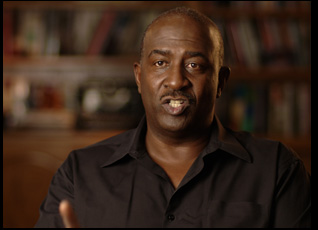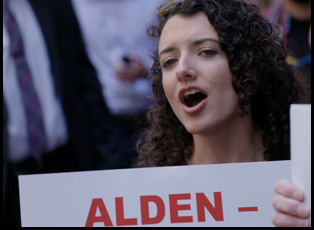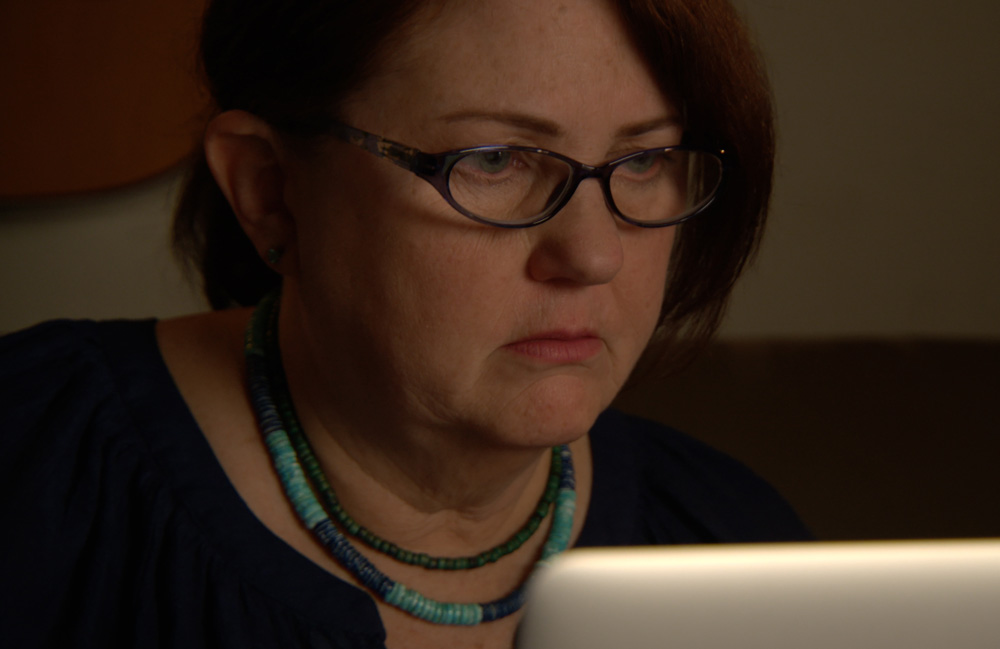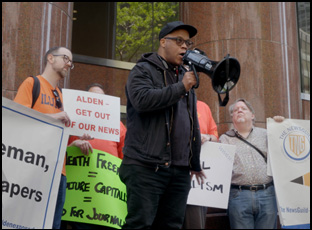When Rick Goldsmith contacted Julie Reynolds about potentially appearing in “Stripped for Parts: American Journalism on the Brink,” it was an unusually fortuitous time. Reynolds, once a reporter for her local newspaper The Monterey Herald in northern California, had been working on a story about Alden Global Capital, the hedge fund that had bought the publication and a host of others around the country in recent years with the express purpose of cutting them down to the bone to maximize their profitability before letting them wither away once they had been fully squeezed. When the impact could be felt all across the U.S. in taking over outlets such as the Denver Post, the Boston Herald and the St. Paul Pioneer Press, their activities were cloaked in secrecy that Reynolds had doggedly sought to uncover, doing so first for herself on a giant pinboard and although what it showed was grim, it could serve as a great illustration for the purposes of a film of what’s already been lost.
“The crazy wall is what Julie calls it, and when we said, ‘We want to film a scene with you, she said, “This is a good time to do it because I’ve outgrown this little board. I’m going to be transferring everything to a bigger board and I can talk about it while you film me,” recalls Goldsmith, who has been tracking shifts in the fifth estate as a filmmaker for some time. “That was perfect because it’s relatable to the audience. They see it on all the crime shows such as “Law and Order” and it’s what she really used to keep all the facts together. What’s this shell company in the Cayman Islands doing? How is that connected to the real estate group Twenty Lake Holdings? It also helped her really explain things step by step for us at certain points in the story.”
In fact, “Stripped for Parts” plays out like crime saga, even if Alden Global Capital has unfortunately adhered by the letter of the law, building a behemoth in Digital First Media that has swooped in on a badly beleaguered news industry where advertising no longer seems like a sustainable financial model and drains its institutions built over decades of what assets they have, from the real estate the publication sits on and their printing presses to staffs so sparse they can’t produce meaningful coverage of their communities. Goldsmith thought he was going to only tell the story of the Denver Post when he started out on the film in 2018, being the largest newspaper at the time to fall into Alden’s clutches and sparking a revolt amongst its staff to attempt to preserve the paper’s high standing, but “Stripped for Parts” takes on a far grander scope as the Post comes to appear as the start of many dominoes to fall and the effects of losing out on rigorous reporting begin to be felt in cities where accountability becomes far more difficult to come by.
Although “Stripped for Parts” doesn’t deny the prospect of death for the entire industry as Alden keeps gobbling up more newspaper chains without other suitors stepping up to save news in their hometowns, Goldsmith is also careful to offer up hope with not only Reynolds using her reporting skills as a form of resistance, but showing journalists everywhere learning new ways to adapt to the current crisis to continue to work towards the public good, whether it’s starting self-sustaining nonprofits or reconsidering the resources they have to maximize their power. With the film now making its way across the country, Goldsmith spoke recently about why it was important for him to shine a light on this underexamined threat to democracy, maintaining focus on a story that just kept growing under his watch and how given the dire circumstances facing journalism, he emerged cautiously optimistic about its future.
I’ve been a news junkie all my life. It’s connected me to the outside world. And when I became a documentary filmmaker, I started doing films on journalism. My two previous films on journalism “Tell the Truth and Run, George Sellers and the American Press,” about a muckraking journalist, independent and also a press critic, [covered] the good, the bad and the ugly of newspapers of those days and then “Daniel Ellsberg: The Most Dangerous Man in America. Daniel Ellsberg and the Pentagon Papers,” [was about] journalism’s brightest moment. So flash forward to 2018 and I come across this article that says, “Alden Global Capital is making so much money wrecking local journalism that it might not want to stop anytime soon.” And I said, “Whoa. What is that all about? Why would an outfit want to make money wrecking local journalism rather than practicing local journalism?” The more I got into it, I found out this was a story of newspaper men and women seizing on a crisis in their industry, which was the demise of local journalism, and specifically in this case, hedge funds in journalism. It started with an investigative reporter named Julie Reynolds, and it went to [Chuck Plunkett], an editorial writer at the Denver Post in 2018 who blasted his own publisher, the hedge fund. Now here were these journalists who never write about their own profession not only covering the story, they were the story.
This is happening in so many places still, but was it easy to keep a focus? I was impressed with how the structure really was from one person to another and wondered if that mirrored your own experience of learning about this when there are so many people this has touched.
Julie Reynolds, the investigative reporter, is the thread that weaves in and out of the film and it was clear that she was only one degree of separation to just about everybody else. But then because there were so many people that had a major role in this story and it was important to give each of them screen time so you got to know them. Structurally, it felt right to go into the screen time of Chuck Plunkett, the editorial writer, Greg Moore, the previous editor of the Denver Post, Tom Peele [at the East Bay Times], Elizabeth Hernandez [at the Denver Post] and Liz Bowie, as they came into the story and to stay with them and see what they were doing, either in their own life as a journalist just covering the world or maybe making some noise and fighting back against the hedge fund that was set to take over their newspaper.

Why it worked out with Tom Peele was we were having trouble getting into the newsrooms because as soon as it became clear who we were and what we were about, all these newsrooms that we were focusing on were either in the process of being taken over by Alden or were already Alden newsrooms, so with Tom Peele, we got him out in the field and you see him walking because “shoe leather reporting” really does describe him. We got him with a younger associate Nate Gartrell and it gave us a number of things. [You see] bantering about with each of them and it gave you a sense, without us actually saying it, of what’s being lost when you lose the senior reporters and editors.
The first thing Alden Global Capital would do [when they bought a newspaper], they would go over the real estate and the second is they’d start to lay off staff or offer buyouts to the more senior reporters because those were the biggest salaries that they could cut. So what you find is we have now more and more newsrooms populated by only younger reporters and very, very few of the older reporters who know where all the bodies are buried and had the Rolodex to to know who to go to in City Hall or who could comment on this because they’d been in the business 10, 20, 30, 40 years. So it was great to have that interaction between the experienced Thomas Peele and Nate Gartrell, and watch them work together. And then Nate talks about [how] every news organization [had a variety of outlets], the Chronicle and this radio station here [in San Francisco] and now I’m the only one left, so it’s a way of of showing this is what’s happening to your journalism and to your community by extension.
What was your own experience with Alden? You end up getting a hold of some anonymous associates to go on the record.
We spent five-and-a-half years on this film [from] 2018 to 2023 and fairly early in the production in 2019, we went to [Alden managing director] Heath Freeman and [Alden founder] Randall Smith with a registered letter saying, “We want to talk to you. When can we arrange that?” And we heard back from their PR people, which was at first we thought was really good news. I ended up having two or three conversations on the phone with their PR people. But by the third conversation, I realized that they he wasn’t in the business of giving me access to Heath Freeman. He was in the business of finding more about who I was, so that went nowhere. Basically, the answer to “can I have a sit down with Heath Freeman?” was no.
We also did our due diligence to find out who are these guys and we went back. Randall Smith had a long history on Wall Street and we did some digging and found two or three people that were willing to to have us record them as soon as long as we said as long as we didn’t identify them or have their voices recognizable in the film. You see a couple of clips of an actor reading from their transcripts, so it was all above board.

Many of the first interviews with Julie, with Greg, with Dave Krieger, another [staffer] from the Denver Post happened within the first couple of months [of our production] by June of 2018 and the word among anybody who commented on this was Alden Global Capital was going to be milking these newspapers for what they were worth, make their money and get out. [They all expected] three years from now, these papers are going to be have disappeared. But that’s not what happened. In the spring of 2019, we found out they were going after Gannett. In other words, they weren’t making their money and then dismantling the papers. They were making money and through this distressed asset investing, they felt they had found a good model for themselves and they wanted to expand the model. That’s when they went after Gannett. So just when we thought we’re going to see how this all played out with the Denver Post and their papers, they’re going after more newspapers.
[Suddenly] we’re covering the takeover of Gannett. Shortly after that, we hear that the Chicago Tribune is in play, so then we had to follow that. What we didn’t expect at the beginning was we were going to see this chain reaction, but it was alarming. It was also something we knew that we had to cover and as soon as I heard about the Chicago Tribune [sale] and there were these two reporters who were organizing to stop that madness, I contacted them. They said, “Come out to Chicago and spend some time with us.” That’s what we did. And it just kept going. At a certain point, even though Alden is still going after new newspapers, you have to wrap up the story, so after we had visited the Baltimore Banner in 2022, we started to wrap things up and finish our edit the following year.It’s a graceful and surprisingly hopeful ending, but was it difficult to land there given all that was going on and what you had seen?
In the midst of the production, anything that was linked towards what’s happening in local journalism, we leapt after and when we found this conference of nonprofit news organizations, the Institute for Nonprofit News (INN). There was also a new startup [in Denver] with The Colorado Sun, just a few months after we started. Then we had this conference where we were able to meet people who were doing nonprofits elsewhere and Julie Reynolds was involved with one of her own, Voices of Monterey Bay. So it became so clear to us that journalists all over the country were addressing this problem, each in their own ways — this group was fighting Alden Global Capital, this group was starting their own [publication] or expanding startups that had maybe been around for several years and then there [were] gatherings where they started talking about public funding of journalism.
I saw that the complete picture was not just the gutting of local journalism by hedge funds, but the creative solution making to reinvigorate and rebuild local journalism. That was an exciting part of it because that was something that gave you hope for what the future is. And I really do feel like these local [publications], especially nonprofits, tend to do more public service journalism than even the legacy papers of yesteryear. They’re not as big, they’re not as powerful. They don’t have the body of lawyers to defend themselves against the people in power that are abusing their power. But the good news is they’re trying to serve the community maybe even more than the legacy journalists by going into the communities that used to have a voice, covering poor people, people of color, labor and things that are not just the concerns of the upper middle class.
“Stripped for Parts: American Journalism on the Brink” is open in Los Angeles through October 10th at the Laemmle Royal with special screenings on October 5th at 4:10 pm and 7:10 pm, followed by a Q & A with Rick Goldsmith. A full list of future screenings is here.





